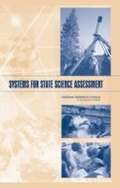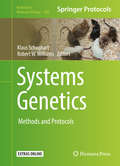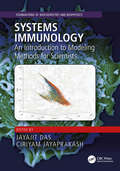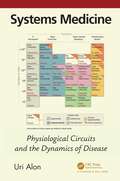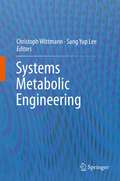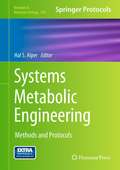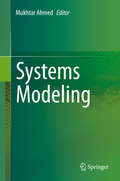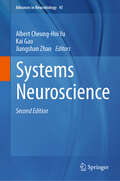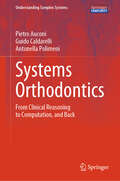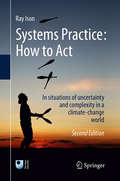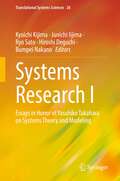- Table View
- List View
Systems For State Science Assessment
by Committee on Test Design for K-12 Science AchievementIn response to the No Child Left Behind Act of 2001 (NCLB), Systems for State Science Assessment explores the ideas and tools that are needed to assess science learning at the state level. This book provides a detailed examination of K-12 science assessment: looking specifically at what should be measured and how to measure it. Along with reading and mathematics, the testing of science is a key component of NCLB—it is part of the national effort to establish challenging academic content standards and develop the tools to measure student progress toward higher achievement. The book will be a critical resource for states that are designing and implementing science assessments to meet the 2007-2008 requirements of NCLB. In addition to offering important information for states, Systems for State Science Assessment provides policy makers, local schools, teachers, scientists, and parents with a broad view of the role of testing and assessment in science education.
Systems Genetics
by Klaus Schughart Robert W. WilliamsThis volume focuses on the use of system genetic methods and the use of murine models to study the role of gene variants and environmental factors on human health and disease--what is now often called personalized or precision health care. The protocols in this book will help readers analyze genetic causes of heritable variation across a wide range of systems and traits using rodent models. The chapters in this book are separated into three sections that cover: 1) resources for systems genetics; 2) tools for analysis and integration in systems genetics; and 3) systems genetics use cases. Written in the highly successful Methods in Molecular Biology series format, chapters include introductions to their respective topics, lists of the necessary materials and tools, step-by-step, readily reproducible protocols, and tips on troubleshooting and avoiding known pitfalls. Practical and thorough, Systems Genetics: Methods and Protocols is a valuable resource for anyone who is interested in this diverse field.
Systems Genetics: Linking Genotypes and Phenotypes
by Florian Markowetz Michael BoutrosWhereas genetic studies have traditionally focused on explaining heritance of single traits and their phenotypes, recent technological advances have made it possible to comprehensively dissect the genetic architecture of complex traits and quantify how genes interact to shape phenotypes. This exciting new area has been termed systems genetics and is born out of a synthesis of multiple fields, integrating a range of approaches and exploiting our increased ability to obtain quantitative and detailed measurements on a broad spectrum of phenotypes. Gathering the contributions of leading scientists, both computational and experimental, this book shows how experimental perturbations can help us to understand the link between genotype and phenotype. A snapshot of current research activity and state-of-the-art approaches to systems genetics are provided, including work from model organisms such as Saccharomyces cerevisiae and Drosophila melanogaster, as well as from human studies.
Systems Immunology: An Introduction to Modeling Methods for Scientists (Foundations of Biochemistry and Biophysics)
by Jayajit Das Ciriyam Jayaprakash"Taken together, the body of information contained in this book provides readers with a bird’s-eye view of different aspects of exciting work at the convergence of disciplines that will ultimately lead to a future where we understand how immunity is regulated, and how we can harness this knowledge toward practical ends that reduce human suffering. I commend the editors for putting this volume together." –Arup K. Chakraborty, Robert T. Haslam Professor of Chemical Engineering, and Professor of Physics, Chemistry, and Biological Engineering, Massachusetts Institute of Technology, Cambridge, USA New experimental techniques in immunology have produced large and complex data sets that require quantitative modeling for analysis. This book provides a complete overview of computational immunology, from basic concepts to mathematical modeling at the single molecule, cellular, organism, and population levels. It showcases modern mechanistic models and their use in making predictions, designing experiments, and elucidating underlying biochemical processes. It begins with an introduction to data analysis, approximations, and assumptions used in model building. Core chapters address models and methods for studying immune responses, with fundamental concepts clearly defined. Readers from immunology, quantitative biology, and applied physics will benefit from the following: Fundamental principles of computational immunology and modern quantitative methods for studying immune response at the single molecule, cellular, organism, and population levels. An overview of basic concepts in modeling and data analysis. Coverage of topics where mechanistic modeling has contributed substantially to current understanding. Discussion of genetic diversity of the immune system, cell signaling in the immune system, immune response at the cell population scale, and ecology of host-pathogen interactions.
Systems Medicine (Methods in Molecular Biology #2486)
by Jane P. F. Bai Junguk HurThis volume explores the latest technological advances and covers all facets of systems medicine with respect to precision medicine. The chapters in this book are organized into four parts. Part One highlights the recent achievements in proteomics for biomarkers identification, integration of omics and phenotypic data for precision medicine, and medicine-guided treatment of drug-induced Stevens-Johnson syndrome. Part Two covers systems-based computational approaches for pharmaceutical research and drug development, the principle of optimizing systemic exposure of drugs, and Animal Rule for drug repurposing. Part Three looks at computational tools and methodologies of network biology, quantitative systems toxicology, and modeling and stimulating patient response variabilities. Part Four talks about how systems medicine can address unmet medical and health needs, and identify educational needs. Written in the highly successful Methods in Molecular Biology series format, chapters include introductions to their respective topics, lists of the necessary materials and reagents, step-by-step, readily reproducible laboratory protocols, and tips on troubleshooting and avoiding known pitfalls.Cutting-edge and thorough, Systems Medicine: Methods and Protocols is a valuable resource for the scientific community that will help researchers work together toward the further advancement of achieving the goal of promoting global health.Chapter 8 is available open access under a Creative Commons Attribution 4.0 International License via link.springer.com
Systems Medicine: Physiological Circuits and the Dynamics of Disease (Chapman & Hall/CRC Computational Biology Series)
by Uri AlonWhy do we get certain diseases, whereas other diseases do not exist? In this book, Alon, one of the founders of systems biology, builds a foundation for systems medicine. Starting from basic laws, the book derives why physiological circuits are built the way they are. The circuits have fragilities that explain specific diseases and offer new strategies to treat them. By the end, the reader will be able to use simple and powerful mathematical models to describe physiological circuits. The book explores, in three parts, hormone circuits, immune circuits, and aging and age-related disease. It culminates in a periodic table of diseases. Alon writes in a style accessible to a broad range of readers - undergraduates, graduates, or researchers from computational or biological backgrounds. The level of math is friendly and the math can even be bypassed altogether. For instructors and readers who want to go deeper, the book includes dozens of exercises that have been rigorously tested in the classroom
Systems Metabolic Engineering
by Sang Yup Lee Christoph WittmannSystems Metabolic Engineering is changing the way microbial cell factories are designed and optimized for industrial production. Integrating systems biology and biotechnology with new concepts from synthetic biology enables the global analysis and engineering of microorganisms and bioprocesses at super efficiency and versatility otherwise not accessible. Without doubt, systems metabolic engineering is a major driver towards bio-based production of chemicals, materials and fuels from renewables and thus one of the core technologies of global green growth. In this book, Christoph Wittmann and Sang-Yup Lee have assembled the world leaders on systems metabolic engineering and cover the full story - from genomes and networks via discovery and design to industrial implementation practises. This book is a comprehensive resource for students and researchers from academia and industry interested in systems metabolic engineering. It provides us with the fundaments to targeted engineering of microbial cells for sustainable bio-production and stimulates those who are interested to enter this exiting research field.
Systems Metabolic Engineering
by Hal S. AlperWith the ultimate goal of systematically and robustly defining the specific perturbations necessary to alter a cellular phenotype, systems metabolic engineering has the potential to lead to a complete cell model capable of simulating cell and metabolic function as well as predicting phenotypic response to changes in media, gene knockouts/overexpressions, or the incorporation of heterologous pathways. In Systems Metabolic Engineering: Methods and Protocols, experts in the field describe the methodologies and approaches in the area of systems metabolic engineering and provide a step-by-step guide for their implementation. Four major tenants of this approach are addressed, including modeling and simulation, multiplexed genome engineering, 'omics technologies, and large data-set incorporation and synthesis, all elucidated through the use of model host organisms. Written in the highly successful Methods in Molecular BiologyTM series format, chapters include introductions on their respective topics, lists of the necessary materials and reagents, step-by-step, readily reproducible laboratory protocols, and tips on troubleshooting and avoiding known pitfalls. Comprehensive and cutting-edge, Systems Metabolic Engineering: Methods and Protocols serves as an ideal guide for metabolic engineers, molecular biologists, and microbiologists aiming to implement the most recent approaches available in the field.
Systems Modeling
by Mukhtar AhmedAchieving food security and economic developmental objectives in the face of climate change and rapid population growth requires systems modelling approaches, for example in the design of sustainable agriculture farming systems. Such approaches increase our understanding of system responses to different soil and climatic conditions, and provide insights into the effects of various variable climate change scenarios, providing valuable information for decision-makers. Further, in the agricultural sector, systems modelling can help optimise crop management and adaptation measures to boost productivity under variable climatic conditions. Presenting key outcomes from crop models used in agricultural systems this book is a valuable resource for professionals interested in using modelling approaches to manage the growth and improve the quality of various crops.
Systems Neuroscience (Advances in Neurobiology #21)
by Albert Cheung-Hoi Yu Lina LiThis edition of Advances in Neurobiology brings together experts in the emerging field of Systems Neuroscience to present an overview of this area of research. Topics covered include: how different neural circuits analyze sensory information, form perceptions of the external world, make decisions, and execute movements; how nerve cells behave when connected together to form neural networks; the relationship between molecular and cellular approaches to understanding brain structure and function; the study of high-level mental functions; and studying brain pathologies and diseases with Systems Neuroscience. A hierarchy of biological complexity arises from the genome, transcriptome, proteome, organelles, cells, synapses, circuits, brain regions, the whole brain, and behaviour. The best way to study the brain, the most complex organ in the body composed of 100 billion cells with trillions of interconnections, is with a Systems Biology approach. Systems biology is an inter-disciplinary field that focuses on complex interactions within biological systems to reveal 'emergent properties' - properties of cells and groups of cells functioning as a system whose actual and theoretical description is only possible using Systems Biology techniques.
Systems Neuroscience (Advances in Neurobiology #41)
by Albert Cheung-Hoi Yu Kai Gao Jiangshan ZhanThe new edition of this popular book brings together experts in the field of Systems Neuroscience to present an overview of the area. Topics covered include how different neural circuits analyze sensory information, form perceptions of the external world, make decisions, and execute movements; how nerve cells behave when connected together to form neural networks; the relationship between molecular and cellular approaches to understanding brain structure and function; the study of high-level mental functions; and studying brain pathologies and disease. Among the topics covered in the new edition are artificial intelligence-assisted computational neuroscience for deciphering neural networks, spatial transcriptomics single cell sequencing, and exome/whole genome sequencing for understanding brain disorders in human genetics. The best way to study the brain, the most complex organ in the body composed of 100 billion neurons with trillions of interconnections, is with a systems biology approach.
Systems Orthodontics: From Clinical Reasoning to Computation, and Back (Understanding Complex Systems)
by Guido Caldarelli Pietro Auconi Antonella PolimeniThis book marks one of the first applications of the Medicine Network discipline to an everyday scenario. It explores situations where patients, often in adolescence, grapple with the decision of whether to commence a treatment, seeking insights into the more plausible future scenarios. Additionally, the specific feedback from biological systems in the human body serves as a potent metaphor for addressing various challenges in the field of Complex Systems. In recent times, systems thinking and complexity theory have yielded substantial conceptual advancements across various research domains. In the context of orthodontics, these approaches offer a more comprehensive understanding in contrast to the traditional mechanistic approach, which primarily focuses on the analysis of applied forces. Systems thinking directs attention to the interaction among dentoskeletal components, where the behavior of one element can influence others. The amalgamation of multiple elements leads to entities with properties distinct from those of individual components. The increasing complexity of orthodontic reality beyond clinical or radiological observations necessitates the development of new theories. Complexity theory has demonstrated that emergent properties in biological systems can be discerned through appropriate computational models, as opposed to the analytical study of individual components. The central metaphor for the interactive craniofacial system during growth is portrayed by the facial topology revealed through network analysis, facilitating a systemic reevaluation of traditional orthodontic theories. This book delineates the novel insights derived from the clinical-computational approach, applicable for a prognostic and early interception perspective in managing dentofacial dysmorphoses. Its objective is to captivate practitioners and persuade them of the practical utility of these innovative approaches.
Systems Practice: How to Act
by Ray IsonIt is now accepted that humans are changing the climate of the Earth and this is the most compelling amongst a long litany of reasons as to why, collectively, we have to change our ways of thinking and acting. Most people now recognise that we have to be capable of adapting quickly as new and uncertain circumstances emerge: this capability will need to exist at personal, group, community, regional, national and international levels, all at the same time. Systems Practice is structured into four parts. Part I introduces the societal need to move towards a more systemic and adaptive governance against the backdrop of human-induced climate change. Part II unpacks what is involved in systems practice by means of a juggler metaphor; examining situations where systems thinking offers useful understanding and opportunities for change. Part III identifies the main factors that constrain the uptake of systems practice and makes the case for innovation in practice by means of systemic inquiry, systemic action research and systemic intervention. The book concludes with Part IV, which critically examines how systems practice is, or might be, utilised at different levels from the personal to the societal. The development of our capabilities to think and act systemically is an urgent priority and Systems Practice aims to show how to do systems thinking and translate that thinking into praxis (theory informed practical action) which will be welcomed by those managing in situations of complexity and uncertainty across all domains of professional and personal concern.
Systems Research I: Essays in Honor of Yasuhiko Takahara on Systems Theory and Modeling (Translational Systems Sciences #26)
by Kyoichi Kijima Hiroshi Deguchi Ryo Sato Junichi Iijima Bumpei NakanoThis book is in honor of Yasuhiko Takahara, a first-class researcher who has been active for some 50 years at the global level in systems research. Researchers and practitioners from Japan and other countries who have been influenced by Takahara have come together from far and wide to contribute their major research masterpieces in the field of systems research in the broadest sense.While the roots of Takahara’s systems research are in general systems theory and systems control theory, he developed his research and teaching in diverse directions such as management information science, engineering, social simulation, and systems thinking. As a result, many of the researchers and practitioners he supervised or influenced have established their own positions and are now active around the world in a wide range of systems research.Volume I is a collection of their masterpieces or representative works in the field of systems theory and modeling.
Systems Research II: Essays in Honor of Yasuhiko Takahara on Systems Management Theory and Practice (Translational Systems Sciences #27)
by Kyoichi Kijima Hiroshi Deguchi Ryo Sato Junichi Iijima Bumpei NakanoThis book is in honor of Yasuhiko Takahara, a first-class researcher who has been active for some 50 years at the global level in systems research. Researchers and practitioners from Japan and other countries who have been influenced by Takahara have come together from far and wide to contribute their major research masterpieces in the field of systems research in the broadest sense.While the roots of Takahara’s systems research are in general systems theory and systems control theory, he developed his research and teaching in diverse directions such as management information science, engineering, social simulation, and systems thinking. As a result, many of the researchers and practitioners he supervised or influenced have established their own positions and are now active around the world in a wide range of systems research.Volume II is a collection of their masterpieces or representative works in the fields of systems management theory and practice.
Systems Science Level 4
by Cheryl Chiapperino Macki Jones Sheri Leasure Lisa WoodA science book set for Christian educators and schools worldwide. Topics covered include: life science: stability, physical sciences, earth & space: balance and human body wellness.
Systems Science: Theory, Analysis, Modeling, and Design
by George E. MobusThis book describes a comprehensive approach to applying systems science formally to the deep analysis of a wide variety of complex systems. Detailed ‘how-to’ examples of the three phases (analysis-modeling-design) of systems science are applied to systems of various types (machines, organic (e.g. ecosystem), and supra-organic (e.g. business organizations and government). The complexity of the global system has reached proportions that seriously challenge our abilities to understand the consequences of our use of technology, modification of natural ecosystems, or even how to govern ourselves. For this reason, complex mathematics is eschewed when simpler structures will suffice, allowing the widest possible audience to apply and benefit from the available tools and concepts of systems science in their own work. The book shows, in detail, how to functionally and structurally deconstruct complex systems using a fundamental language of systems. It shows how to capture the discovered details in a structured knowledge base from which abstract models can be derived for simulation. The knowledge base is also shown to be a basis for generating system design specifications for human-built artifacts, or policy recommendations/policy mechanisms for socio-economic-ecological systems management. The book builds on principles and methods found in the authors’ textbook Principles of Systems Science (co-authored with Michael Kalton), but without prerequisites. It will appeal to a broad audience that deals with complex systems every day, from design engineers to economic and ecological systems managers and policymakers.
Systems Theory and PDEs: Open Problems, Recent Results, and New Directions (Trends in Mathematics)
by Marcus Waurick Felix L. SchwenningerThis volume presents recent advances and open problems in the cross section of infinite-dimensional systems theory and the modern treatment of PDEs. Chapters are based on talks and problem sessions from the first “Workshop on Systems Theory and PDEs” (WOSTAP), held at TU Bergakademie Freiberg in July 2022. The main topics covered include: Differential algebraic equations Port-Hamiltonian systems in both finite and infinite dimensions Highly nonlinear equations related to elasticity/plasticity Modeling of thermo-piezo-electromagnetism
Systems Theory for Engineering Practice: Insights from Physics
by Jie Yu Maosheng ZhengThis book presents cognition of the universality of systems theory thinking by using some ordinary physical phenomena and their methods in study, of which the involved treatments are consistent with the viewpoint of systems theory. It contains the collective actions of classical vibration of many bodies and wave, the extreme value problem in natural world, status of electrons in atom-molecule and metals, Ising model in phase transition and elementary excitation in solid, multi-objective optimization in a system, description of effective media approximation, certainty in uncertain phenomena, all these reflect the cooperative/synergetic effects, wholeness of group actions, “unity of opposites” inside a system, and collective phenomena in a system completely. The relevant methodologies for systems theory are organic combination and synergism of both “reductionism” and “holism” instead of “confrontation” or “separation” of them, which could be used in dealing with analogous problems in systems science and engineering fields in response to the idiom of “stones from other hills being good for polishing this jade” and “comprehend by analogy”, so as to promote the transformation of wisdom to productivity. The authors wish this work could play its role as a paving stone to serve the research and application of systems theory. This book can be used as a textbook for postgraduate and advanced undergraduate students in relevant majors, and a reference book for scientists and practitioners in related fields.
Systems Theory for Pragmatic Schooling: Toward Principles of Democratic Education
by Craig A. CunninghamWriting for educators and education leaders, Cunningham shows that combining a philosophy of pragmatism with thinking about education as systems can illuminate challenges in contemporary schooling and provide practical solutions for creating a democratic education.
Systems Theory in Data and Optimization: Proceedings of SysDO 2024 (Lecture Notes in Control and Information Sciences - Proceedings)
by Frank Allgöwer Julian Berberich Andrea IannelliThis book contains the proceedings of the Symposium on Systems Theory in Data and Optimization (SysDO) held in Stuttgart, Germany, from 30th September to 2nd October 2024. It addresses theoretical and practical research questions arising at the intersection of systems and control theory, data, and optimization. The increasing prevalence of cyber-physical systems sparks the need for new methods to integrate measured data and different forms of feedback, especially optimization-based feedback, inside the decision-making mechanism. There are distinctive challenges that arise in this scenario, such as the existence of different time-scales, the need to guarantee sufficient richness of the collected data, and the effect of suboptimal decisions under uncertainty. This book presents new methods and applications addressing these challenges. This book is a valuable source on latest research findings spanning diverse topics including: data-driven and learning-based control; theory and applications of machine learning; model predictive control; and optimization.
Systems Thinkers
by Karen Shipp Magnus RamageThis book presents a biographical history of the field of systems thinking, by examining the life and work of thirty of its major thinkers. It discusses each thinker's key contributions, the way this contribution was expressed in practice and the relationship between their life and ideas. This discussion is supported by an extract from the thinker's own writing, to give a flavour of their work and to give readers a sense of which thinkers are most relevant to their own interests.
Systems Thinking Approach for Social Problems
by Vivek Vijay Sandeep Kumar Yadav Bibhas Adhikari Harinipriya Seshadri Deepak Kumar FulwaniThe book is a collection of peer-reviewed scientific papers submitted by active researchers in the 37th National System Conference (NSC 2013). NSC is an annual event of the Systems Society of India (SSI), primarily oriented to strengthen the systems movement and its applications for the welfare of humanity. A galaxy of academicians, professionals, scientists, statesman and researchers from different parts of the country and abroad are invited to attend the conference. The book presents research articles in the areas of system's modelling, complex network modelling, cyber security, sustainable systems design, health care systems, socio-economic systems, and clean and green technologies. The book can be used as a tool for further research.
Systems Thinking Basics: From Concepts to Causal Loops
by Virginia Anderson Lauren Johnson<p>Systems Thinking Basics is a self-study, skill-building resource designed to introduce you to the power of systems thinking tools. With an emphasis on behavior over time graphs and causal loop diagrams, this workbook guides you step by step through: Recognizing systems and understanding the importance of systems thinking; Interpreting and creating behavior over time graphs and causal loop diagrams; Applying and practicing systems thinking day-to-day. <p>Each of the book's six main sections contains a wealth of examples from the business world, as well as learning activities that reinforce concepts and provide you with the opportunity and space to practice. An array of appendices offers: Extra practice activities; A summary of key points and suggested responses to the learning activities; A table showing the "palette" of systems thinking tools available; A glossary of systems thinking terms; A list of additional resources; A summary of the systems archetypes. <p>The many diagrams within the book clarify concepts and visually reinforce key principles. Systems Thinking Basics is ideal for aspiring systems thinkers eager to try their hand at using these powerful tools</p>
Systems Thinking and Viable Systems (Routledge-Giappichelli Systems Management)
by Sergio BarileIn the last few decades, managerial and business studies have shown an increasing inability to explain and forecast emergent dynamics in society, economics, and the environment.Consolidated managerial approaches and business theories seem to be incapable of communicating and depicting the ongoing evolution, and new perspectives are required to support both researchers and practitioners in tracing new paths for development. Building upon the constructivist approach, this book illustrates the multiple advantages that systems thinking can offer in supporting a holistic understanding of social and economic phenomena.The book proposes a representation of the firm as a viable system and represents its functioning and decision-making processes trough a recursive depiction that can be applied for each of the multiple levels through which socio-economic environments are defined. As a result of the focus on the differences between decision making and problem-solving processes, the book enriches current knowledge about systems thinking and provides useful instruments through which both researchers and practitioners can effectively understand the multiple variables able to influence decisions and actions within a firm’s configuration.The book is aimed at both postgraduate students and researchers interested in the multiple dimensions of systems thinking.
